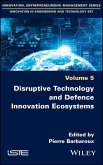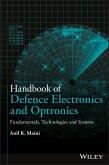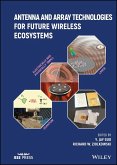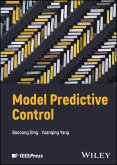Disruptive Technology and Defence Innovation Ecosystems (eBook, PDF)
Redaktion: Barbaroux, Pierre
139,99 €
139,99 €
inkl. MwSt.
Sofort per Download lieferbar

0 °P sammeln
139,99 €
Als Download kaufen

139,99 €
inkl. MwSt.
Sofort per Download lieferbar

0 °P sammeln
Jetzt verschenken
Alle Infos zum eBook verschenken
139,99 €
inkl. MwSt.
Sofort per Download lieferbar
Alle Infos zum eBook verschenken

0 °P sammeln
Disruptive Technology and Defence Innovation Ecosystems (eBook, PDF)
Redaktion: Barbaroux, Pierre
- Format: PDF
- Merkliste
- Auf die Merkliste
- Bewerten Bewerten
- Teilen
- Produkt teilen
- Produkterinnerung
- Produkterinnerung

Bitte loggen Sie sich zunächst in Ihr Kundenkonto ein oder registrieren Sie sich bei
bücher.de, um das eBook-Abo tolino select nutzen zu können.
Hier können Sie sich einloggen
Hier können Sie sich einloggen
Sie sind bereits eingeloggt. Klicken Sie auf 2. tolino select Abo, um fortzufahren.

Bitte loggen Sie sich zunächst in Ihr Kundenkonto ein oder registrieren Sie sich bei bücher.de, um das eBook-Abo tolino select nutzen zu können.
Recent advances in the disciplines of computer science (e.g., quantum theory, artificial intelligence), biotechnology and nanotechnology have deeply modified the structures of knowledge from which military capabilities are likely to develop. This book discusses the implications of disruptive technologies for the defence innovation ecosystem. Two complementary dimensions of the defence innovation ecosystem are highlighted: the industrial and intra-organizational. On the industrial scale, there is a shift in the ecology of knowledge underpinning the defence industrial and technological base…mehr
- Geräte: PC
- mit Kopierschutz
- eBook Hilfe
- Größe: 9.32MB
Andere Kunden interessierten sich auch für
![Disruptive Technology and Defence Innovation Ecosystems (eBook, ePUB) Disruptive Technology and Defence Innovation Ecosystems (eBook, ePUB)]() Disruptive Technology and Defence Innovation Ecosystems (eBook, ePUB)139,99 €
Disruptive Technology and Defence Innovation Ecosystems (eBook, ePUB)139,99 €![Handbook of Defence Electronics and Optronics (eBook, PDF) Handbook of Defence Electronics and Optronics (eBook, PDF)]() Anil K. MainiHandbook of Defence Electronics and Optronics (eBook, PDF)218,99 €
Anil K. MainiHandbook of Defence Electronics and Optronics (eBook, PDF)218,99 €![Advanced Science and Technology for Biological Decontamination of Sites Affected by Chemical and Radiological Nuclear Agents (eBook, PDF) Advanced Science and Technology for Biological Decontamination of Sites Affected by Chemical and Radiological Nuclear Agents (eBook, PDF)]() Advanced Science and Technology for Biological Decontamination of Sites Affected by Chemical and Radiological Nuclear Agents (eBook, PDF)112,95 €
Advanced Science and Technology for Biological Decontamination of Sites Affected by Chemical and Radiological Nuclear Agents (eBook, PDF)112,95 €![Antenna and Array Technologies for Future Wireless Ecosystems (eBook, PDF) Antenna and Array Technologies for Future Wireless Ecosystems (eBook, PDF)]() Antenna and Array Technologies for Future Wireless Ecosystems (eBook, PDF)115,99 €
Antenna and Array Technologies for Future Wireless Ecosystems (eBook, PDF)115,99 €![Systems Science for Engineers and Scholars (eBook, PDF) Systems Science for Engineers and Scholars (eBook, PDF)]() Avner EngelSystems Science for Engineers and Scholars (eBook, PDF)108,99 €
Avner EngelSystems Science for Engineers and Scholars (eBook, PDF)108,99 €![Evolution of Wireless Communication Ecosystems (eBook, PDF) Evolution of Wireless Communication Ecosystems (eBook, PDF)]() Suat SecginEvolution of Wireless Communication Ecosystems (eBook, PDF)100,99 €
Suat SecginEvolution of Wireless Communication Ecosystems (eBook, PDF)100,99 €![Model Predictive Control (eBook, PDF) Model Predictive Control (eBook, PDF)]() Baocang DingModel Predictive Control (eBook, PDF)106,99 €
Baocang DingModel Predictive Control (eBook, PDF)106,99 €-
-
-
Recent advances in the disciplines of computer science (e.g., quantum theory, artificial intelligence), biotechnology and nanotechnology have deeply modified the structures of knowledge from which military capabilities are likely to develop. This book discusses the implications of disruptive technologies for the defence innovation ecosystem. Two complementary dimensions of the defence innovation ecosystem are highlighted: the industrial and intra-organizational. On the industrial scale, there is a shift in the ecology of knowledge underpinning the defence industrial and technological base (DITB). At the intra-organizational level, it is the actors' practices that change and, through them, their skills and the processes by which they are acquired and transferred. In this context, the sources and legitimacy of innovation are being transformed, in turn requiring sometimes radical adaptations on the part of the various actors, including companies, military services, research communities and governmental agencies, which make up the defence innovation ecosystem.
Dieser Download kann aus rechtlichen Gründen nur mit Rechnungsadresse in D ausgeliefert werden.
Produktdetails
- Produktdetails
- Verlag: John Wiley & Sons
- Erscheinungstermin: 10. Juli 2019
- Englisch
- ISBN-13: 9781119644583
- Artikelnr.: 58582360
- Verlag: John Wiley & Sons
- Erscheinungstermin: 10. Juli 2019
- Englisch
- ISBN-13: 9781119644583
- Artikelnr.: 58582360
- Herstellerkennzeichnung Die Herstellerinformationen sind derzeit nicht verfügbar.
Pierre Barbaroux is a full-time professor at the Ecole de l'air, France, where he is co-director of the Aerospace Cyber Resilience Research Chair and program director of the Advanced Master in Aerospace Project Management. He is also Vice-President of Scientific Cooperation of the Research Network on Innovation.
Introduction xi
Pierre BARBAROUX
Part 1. Transformation of the Innovation Organization Model in the Defence
Sector 1
Chapter 1. Innovation Dynamics in Defence Industries 3
Jean BELIN and Marianne GUILLE
1.1. Introduction 3
1.2. Transformation of the defence industry's innovation environment 4
1.2.1. Changes in the science and technology system 5
1.2.2. Intensifying competition and increasing complexity of the knowledge
mobilized 10
1.2.3. Less dependence on defence financing 14
1.3. Opening of the defence sector 19
1.3.1. Development of duality 19
1.3.2. More cooperation 21
1.3.3. New institutions and stronger links with academic research 23
1.4. Conclusion 26
1.5. References 27
Chapter 2. Evolution of the Aerospace and Defence Innovation Model:
Intensifying Science and Technology Relationships 31
Cécile FAUCONNET
2.1. Introduction 31
2.2. Reflection framework 33
2.2.1. Defence innovation 33
2.2.2. Knowledge-based innovation 35
2.3. Methodology 37
2.3.1. Bibliometric approach 37
2.3.2. Data source and analysis 39
2.4. Results 43
2.4.1. Descriptive analysis 43
2.4.2. Scientific knowledge and quality of technological innovation 47
2.5. Conclusion 50
2.6. Appendices 50
2.7. References 53
Chapter 3. Identification of Defence Technological Knowledge Systems: A
Tool for Duality Analysis 59
François-Xavier MEUNIER
3.1. Introduction 59
3.2. Definition of a TKS and defence innovation 60
3.3. Data 63
3.4. Methodology 66
3.5. Results 70
3.6. Conclusion 76
3.7. References 77
Chapter 4. Defence Aerospace Firms: What Are the Technological Coherence of
Their R&D? 81
Cécile FAUCONNET, Didier LEBERT, Célia ZYLA and Sylvain MOURA
4.1. Introduction 81
4.2. Assumptions on the relatedness and technological coherence of DA firms
83
4.3. Measuring technological coherence 86
4.4. The data: scope and content 89
4.5. Main results 96
4.6. Conclusion 100
4.7. References 100
Chapter 5. Innovation and Legitimacy: The Case of Remotely Piloted Aircraft
Systems 105
Pierre BARBAROUX
5.1. Introduction 105
5.2. Technological innovation and legitimacy 108
5.3. The ecosystem of RPAS in France 110
5.4. The role of the French Air Force RPAS Center of Excellence (CED) in
legitimizing RPAS systems 114
5.5. Implications and conclusion 117
5.6. References 119
Part 2. Transformation of Skills and Uses Induced by Innovations 121
Chapter 6. Man-machine Teaming: Towards a New Paradigm of Man-machine
Collaboration? 123
Vincent FERRARI
6.1. The challenges of collaboration 123
6.2. The sharing of human-machine authority: the premises of collaboration
125
6.3. Expert systems and human-system collaboration 128
6.4. AI and collaboration between human and artificial agents 129
6.4.1. The omnipresence of weak AI 130
6.4.2. The opacity of weak AI 130
6.4.3. A mistrust of weak AI 132
6.4.4. Strong AI for human-system collaboration? 133
6.5. Seeing beyond cognition to innovate 134
6.6. Conclusion 135
6.7. References 136
Chapter 7. Perspectives and Ambitions of the Maintenance in Operational
Condition Renovated at the Heart of the Armament Programs: Illustrations in
the Terrestrial Environment 139
Nicolas HUÉ, Walter ARNAUD and Christophe GRANDEMANGE
7.1. Introduction 139
7.2. Context and future challenges of the MCO 140
7.2.1. End-to-end construction, from upstream phases to the in-service use
phase 140
7.2.2. The necessary awareness of stakeholder responsibilities 141
7.2.3 What are the support mechanisms for better industrial accountability?
142
7.2.4. The influence of the environment 143
7.2.5. Financial issues that are central to the work 144
7.3. Innovations for the MCO of the future: the prerequisite for
digitization 144
7.3.1. The necessary digitization of the MCO 144
7.3.2. The foundation of digitization: RFID, HUMS and interoperability. 145
7.4. Innovations for the MCO of the future: research and innovation
challenges 150
7.4.1. Predictions of optimal maintenance plans: artificial intelligence
and big data 150
7.4.2. Augmented and virtual reality (AR/VR) 151
7.4.3. 3D printing 151
7.4.4. Remote maintenance 152
7.5. Some safeguards 152
7.5.1. Technology at the service of humans 152
7.5.2. Jobs and skills that need to be managed in symbiosis 153
7.5.3. A strategic challenge for the DITB 153
7.6. Prospects for the future 154
Chapter 8. Technological Change and Individual Competencies: The Influence
of Glass-cockpit Aircraft on French Air Force Pilots Training and Skills
155
Cyril CAMACHON and Pierre BARBAROUX
8.1. Introduction 155
8.2. The pilot training model: epistemological foundations and typology of
skills 157
8.3. Research context 159
8.3.1. Data sources and analyses 159
8.3.2. The initial training phase at Salon-de-Provence 161
8.4. Digitization of glass cockpits: what are the implications for pilot
training? 163
8.4.1. The basic technical skills revisited 163
8.4.2. Reconfiguring the training toolset? The role of embedded simulation
169
8.5. Discussion and conclusion 174
8.6. References 177
Chapter 9. Towards the Advent of High-Altitude Pseudo-Satellites (HAPS)
181
Bertrand KIRSCH and Olivier MONTAGNIER
9.1. Introduction 181
9.2. Capability issues: observation and telecommunications. 184
9.3. Solar flight history: projects, records and accidents 185
9.4. Resolution of a scientific and technological paradox 191
9.4.1. Solar energy: unlimited? 192
9.4.2. The keys to endurance 193
9.4.3. A technological challenge: the aeroelasticity of flexible wings 194
9.4.4. An alternative way to remedy flutter: aeroelastic weaving 197
9.5. Conclusion 199
9.6. References 200
Conclusion 203
Pierre BARBAROUX
List of Authors 209
Index 211
Pierre BARBAROUX
Part 1. Transformation of the Innovation Organization Model in the Defence
Sector 1
Chapter 1. Innovation Dynamics in Defence Industries 3
Jean BELIN and Marianne GUILLE
1.1. Introduction 3
1.2. Transformation of the defence industry's innovation environment 4
1.2.1. Changes in the science and technology system 5
1.2.2. Intensifying competition and increasing complexity of the knowledge
mobilized 10
1.2.3. Less dependence on defence financing 14
1.3. Opening of the defence sector 19
1.3.1. Development of duality 19
1.3.2. More cooperation 21
1.3.3. New institutions and stronger links with academic research 23
1.4. Conclusion 26
1.5. References 27
Chapter 2. Evolution of the Aerospace and Defence Innovation Model:
Intensifying Science and Technology Relationships 31
Cécile FAUCONNET
2.1. Introduction 31
2.2. Reflection framework 33
2.2.1. Defence innovation 33
2.2.2. Knowledge-based innovation 35
2.3. Methodology 37
2.3.1. Bibliometric approach 37
2.3.2. Data source and analysis 39
2.4. Results 43
2.4.1. Descriptive analysis 43
2.4.2. Scientific knowledge and quality of technological innovation 47
2.5. Conclusion 50
2.6. Appendices 50
2.7. References 53
Chapter 3. Identification of Defence Technological Knowledge Systems: A
Tool for Duality Analysis 59
François-Xavier MEUNIER
3.1. Introduction 59
3.2. Definition of a TKS and defence innovation 60
3.3. Data 63
3.4. Methodology 66
3.5. Results 70
3.6. Conclusion 76
3.7. References 77
Chapter 4. Defence Aerospace Firms: What Are the Technological Coherence of
Their R&D? 81
Cécile FAUCONNET, Didier LEBERT, Célia ZYLA and Sylvain MOURA
4.1. Introduction 81
4.2. Assumptions on the relatedness and technological coherence of DA firms
83
4.3. Measuring technological coherence 86
4.4. The data: scope and content 89
4.5. Main results 96
4.6. Conclusion 100
4.7. References 100
Chapter 5. Innovation and Legitimacy: The Case of Remotely Piloted Aircraft
Systems 105
Pierre BARBAROUX
5.1. Introduction 105
5.2. Technological innovation and legitimacy 108
5.3. The ecosystem of RPAS in France 110
5.4. The role of the French Air Force RPAS Center of Excellence (CED) in
legitimizing RPAS systems 114
5.5. Implications and conclusion 117
5.6. References 119
Part 2. Transformation of Skills and Uses Induced by Innovations 121
Chapter 6. Man-machine Teaming: Towards a New Paradigm of Man-machine
Collaboration? 123
Vincent FERRARI
6.1. The challenges of collaboration 123
6.2. The sharing of human-machine authority: the premises of collaboration
125
6.3. Expert systems and human-system collaboration 128
6.4. AI and collaboration between human and artificial agents 129
6.4.1. The omnipresence of weak AI 130
6.4.2. The opacity of weak AI 130
6.4.3. A mistrust of weak AI 132
6.4.4. Strong AI for human-system collaboration? 133
6.5. Seeing beyond cognition to innovate 134
6.6. Conclusion 135
6.7. References 136
Chapter 7. Perspectives and Ambitions of the Maintenance in Operational
Condition Renovated at the Heart of the Armament Programs: Illustrations in
the Terrestrial Environment 139
Nicolas HUÉ, Walter ARNAUD and Christophe GRANDEMANGE
7.1. Introduction 139
7.2. Context and future challenges of the MCO 140
7.2.1. End-to-end construction, from upstream phases to the in-service use
phase 140
7.2.2. The necessary awareness of stakeholder responsibilities 141
7.2.3 What are the support mechanisms for better industrial accountability?
142
7.2.4. The influence of the environment 143
7.2.5. Financial issues that are central to the work 144
7.3. Innovations for the MCO of the future: the prerequisite for
digitization 144
7.3.1. The necessary digitization of the MCO 144
7.3.2. The foundation of digitization: RFID, HUMS and interoperability. 145
7.4. Innovations for the MCO of the future: research and innovation
challenges 150
7.4.1. Predictions of optimal maintenance plans: artificial intelligence
and big data 150
7.4.2. Augmented and virtual reality (AR/VR) 151
7.4.3. 3D printing 151
7.4.4. Remote maintenance 152
7.5. Some safeguards 152
7.5.1. Technology at the service of humans 152
7.5.2. Jobs and skills that need to be managed in symbiosis 153
7.5.3. A strategic challenge for the DITB 153
7.6. Prospects for the future 154
Chapter 8. Technological Change and Individual Competencies: The Influence
of Glass-cockpit Aircraft on French Air Force Pilots Training and Skills
155
Cyril CAMACHON and Pierre BARBAROUX
8.1. Introduction 155
8.2. The pilot training model: epistemological foundations and typology of
skills 157
8.3. Research context 159
8.3.1. Data sources and analyses 159
8.3.2. The initial training phase at Salon-de-Provence 161
8.4. Digitization of glass cockpits: what are the implications for pilot
training? 163
8.4.1. The basic technical skills revisited 163
8.4.2. Reconfiguring the training toolset? The role of embedded simulation
169
8.5. Discussion and conclusion 174
8.6. References 177
Chapter 9. Towards the Advent of High-Altitude Pseudo-Satellites (HAPS)
181
Bertrand KIRSCH and Olivier MONTAGNIER
9.1. Introduction 181
9.2. Capability issues: observation and telecommunications. 184
9.3. Solar flight history: projects, records and accidents 185
9.4. Resolution of a scientific and technological paradox 191
9.4.1. Solar energy: unlimited? 192
9.4.2. The keys to endurance 193
9.4.3. A technological challenge: the aeroelasticity of flexible wings 194
9.4.4. An alternative way to remedy flutter: aeroelastic weaving 197
9.5. Conclusion 199
9.6. References 200
Conclusion 203
Pierre BARBAROUX
List of Authors 209
Index 211
Introduction xi
Pierre BARBAROUX
Part 1. Transformation of the Innovation Organization Model in the Defence
Sector 1
Chapter 1. Innovation Dynamics in Defence Industries 3
Jean BELIN and Marianne GUILLE
1.1. Introduction 3
1.2. Transformation of the defence industry's innovation environment 4
1.2.1. Changes in the science and technology system 5
1.2.2. Intensifying competition and increasing complexity of the knowledge
mobilized 10
1.2.3. Less dependence on defence financing 14
1.3. Opening of the defence sector 19
1.3.1. Development of duality 19
1.3.2. More cooperation 21
1.3.3. New institutions and stronger links with academic research 23
1.4. Conclusion 26
1.5. References 27
Chapter 2. Evolution of the Aerospace and Defence Innovation Model:
Intensifying Science and Technology Relationships 31
Cécile FAUCONNET
2.1. Introduction 31
2.2. Reflection framework 33
2.2.1. Defence innovation 33
2.2.2. Knowledge-based innovation 35
2.3. Methodology 37
2.3.1. Bibliometric approach 37
2.3.2. Data source and analysis 39
2.4. Results 43
2.4.1. Descriptive analysis 43
2.4.2. Scientific knowledge and quality of technological innovation 47
2.5. Conclusion 50
2.6. Appendices 50
2.7. References 53
Chapter 3. Identification of Defence Technological Knowledge Systems: A
Tool for Duality Analysis 59
François-Xavier MEUNIER
3.1. Introduction 59
3.2. Definition of a TKS and defence innovation 60
3.3. Data 63
3.4. Methodology 66
3.5. Results 70
3.6. Conclusion 76
3.7. References 77
Chapter 4. Defence Aerospace Firms: What Are the Technological Coherence of
Their R&D? 81
Cécile FAUCONNET, Didier LEBERT, Célia ZYLA and Sylvain MOURA
4.1. Introduction 81
4.2. Assumptions on the relatedness and technological coherence of DA firms
83
4.3. Measuring technological coherence 86
4.4. The data: scope and content 89
4.5. Main results 96
4.6. Conclusion 100
4.7. References 100
Chapter 5. Innovation and Legitimacy: The Case of Remotely Piloted Aircraft
Systems 105
Pierre BARBAROUX
5.1. Introduction 105
5.2. Technological innovation and legitimacy 108
5.3. The ecosystem of RPAS in France 110
5.4. The role of the French Air Force RPAS Center of Excellence (CED) in
legitimizing RPAS systems 114
5.5. Implications and conclusion 117
5.6. References 119
Part 2. Transformation of Skills and Uses Induced by Innovations 121
Chapter 6. Man-machine Teaming: Towards a New Paradigm of Man-machine
Collaboration? 123
Vincent FERRARI
6.1. The challenges of collaboration 123
6.2. The sharing of human-machine authority: the premises of collaboration
125
6.3. Expert systems and human-system collaboration 128
6.4. AI and collaboration between human and artificial agents 129
6.4.1. The omnipresence of weak AI 130
6.4.2. The opacity of weak AI 130
6.4.3. A mistrust of weak AI 132
6.4.4. Strong AI for human-system collaboration? 133
6.5. Seeing beyond cognition to innovate 134
6.6. Conclusion 135
6.7. References 136
Chapter 7. Perspectives and Ambitions of the Maintenance in Operational
Condition Renovated at the Heart of the Armament Programs: Illustrations in
the Terrestrial Environment 139
Nicolas HUÉ, Walter ARNAUD and Christophe GRANDEMANGE
7.1. Introduction 139
7.2. Context and future challenges of the MCO 140
7.2.1. End-to-end construction, from upstream phases to the in-service use
phase 140
7.2.2. The necessary awareness of stakeholder responsibilities 141
7.2.3 What are the support mechanisms for better industrial accountability?
142
7.2.4. The influence of the environment 143
7.2.5. Financial issues that are central to the work 144
7.3. Innovations for the MCO of the future: the prerequisite for
digitization 144
7.3.1. The necessary digitization of the MCO 144
7.3.2. The foundation of digitization: RFID, HUMS and interoperability. 145
7.4. Innovations for the MCO of the future: research and innovation
challenges 150
7.4.1. Predictions of optimal maintenance plans: artificial intelligence
and big data 150
7.4.2. Augmented and virtual reality (AR/VR) 151
7.4.3. 3D printing 151
7.4.4. Remote maintenance 152
7.5. Some safeguards 152
7.5.1. Technology at the service of humans 152
7.5.2. Jobs and skills that need to be managed in symbiosis 153
7.5.3. A strategic challenge for the DITB 153
7.6. Prospects for the future 154
Chapter 8. Technological Change and Individual Competencies: The Influence
of Glass-cockpit Aircraft on French Air Force Pilots Training and Skills
155
Cyril CAMACHON and Pierre BARBAROUX
8.1. Introduction 155
8.2. The pilot training model: epistemological foundations and typology of
skills 157
8.3. Research context 159
8.3.1. Data sources and analyses 159
8.3.2. The initial training phase at Salon-de-Provence 161
8.4. Digitization of glass cockpits: what are the implications for pilot
training? 163
8.4.1. The basic technical skills revisited 163
8.4.2. Reconfiguring the training toolset? The role of embedded simulation
169
8.5. Discussion and conclusion 174
8.6. References 177
Chapter 9. Towards the Advent of High-Altitude Pseudo-Satellites (HAPS)
181
Bertrand KIRSCH and Olivier MONTAGNIER
9.1. Introduction 181
9.2. Capability issues: observation and telecommunications. 184
9.3. Solar flight history: projects, records and accidents 185
9.4. Resolution of a scientific and technological paradox 191
9.4.1. Solar energy: unlimited? 192
9.4.2. The keys to endurance 193
9.4.3. A technological challenge: the aeroelasticity of flexible wings 194
9.4.4. An alternative way to remedy flutter: aeroelastic weaving 197
9.5. Conclusion 199
9.6. References 200
Conclusion 203
Pierre BARBAROUX
List of Authors 209
Index 211
Pierre BARBAROUX
Part 1. Transformation of the Innovation Organization Model in the Defence
Sector 1
Chapter 1. Innovation Dynamics in Defence Industries 3
Jean BELIN and Marianne GUILLE
1.1. Introduction 3
1.2. Transformation of the defence industry's innovation environment 4
1.2.1. Changes in the science and technology system 5
1.2.2. Intensifying competition and increasing complexity of the knowledge
mobilized 10
1.2.3. Less dependence on defence financing 14
1.3. Opening of the defence sector 19
1.3.1. Development of duality 19
1.3.2. More cooperation 21
1.3.3. New institutions and stronger links with academic research 23
1.4. Conclusion 26
1.5. References 27
Chapter 2. Evolution of the Aerospace and Defence Innovation Model:
Intensifying Science and Technology Relationships 31
Cécile FAUCONNET
2.1. Introduction 31
2.2. Reflection framework 33
2.2.1. Defence innovation 33
2.2.2. Knowledge-based innovation 35
2.3. Methodology 37
2.3.1. Bibliometric approach 37
2.3.2. Data source and analysis 39
2.4. Results 43
2.4.1. Descriptive analysis 43
2.4.2. Scientific knowledge and quality of technological innovation 47
2.5. Conclusion 50
2.6. Appendices 50
2.7. References 53
Chapter 3. Identification of Defence Technological Knowledge Systems: A
Tool for Duality Analysis 59
François-Xavier MEUNIER
3.1. Introduction 59
3.2. Definition of a TKS and defence innovation 60
3.3. Data 63
3.4. Methodology 66
3.5. Results 70
3.6. Conclusion 76
3.7. References 77
Chapter 4. Defence Aerospace Firms: What Are the Technological Coherence of
Their R&D? 81
Cécile FAUCONNET, Didier LEBERT, Célia ZYLA and Sylvain MOURA
4.1. Introduction 81
4.2. Assumptions on the relatedness and technological coherence of DA firms
83
4.3. Measuring technological coherence 86
4.4. The data: scope and content 89
4.5. Main results 96
4.6. Conclusion 100
4.7. References 100
Chapter 5. Innovation and Legitimacy: The Case of Remotely Piloted Aircraft
Systems 105
Pierre BARBAROUX
5.1. Introduction 105
5.2. Technological innovation and legitimacy 108
5.3. The ecosystem of RPAS in France 110
5.4. The role of the French Air Force RPAS Center of Excellence (CED) in
legitimizing RPAS systems 114
5.5. Implications and conclusion 117
5.6. References 119
Part 2. Transformation of Skills and Uses Induced by Innovations 121
Chapter 6. Man-machine Teaming: Towards a New Paradigm of Man-machine
Collaboration? 123
Vincent FERRARI
6.1. The challenges of collaboration 123
6.2. The sharing of human-machine authority: the premises of collaboration
125
6.3. Expert systems and human-system collaboration 128
6.4. AI and collaboration between human and artificial agents 129
6.4.1. The omnipresence of weak AI 130
6.4.2. The opacity of weak AI 130
6.4.3. A mistrust of weak AI 132
6.4.4. Strong AI for human-system collaboration? 133
6.5. Seeing beyond cognition to innovate 134
6.6. Conclusion 135
6.7. References 136
Chapter 7. Perspectives and Ambitions of the Maintenance in Operational
Condition Renovated at the Heart of the Armament Programs: Illustrations in
the Terrestrial Environment 139
Nicolas HUÉ, Walter ARNAUD and Christophe GRANDEMANGE
7.1. Introduction 139
7.2. Context and future challenges of the MCO 140
7.2.1. End-to-end construction, from upstream phases to the in-service use
phase 140
7.2.2. The necessary awareness of stakeholder responsibilities 141
7.2.3 What are the support mechanisms for better industrial accountability?
142
7.2.4. The influence of the environment 143
7.2.5. Financial issues that are central to the work 144
7.3. Innovations for the MCO of the future: the prerequisite for
digitization 144
7.3.1. The necessary digitization of the MCO 144
7.3.2. The foundation of digitization: RFID, HUMS and interoperability. 145
7.4. Innovations for the MCO of the future: research and innovation
challenges 150
7.4.1. Predictions of optimal maintenance plans: artificial intelligence
and big data 150
7.4.2. Augmented and virtual reality (AR/VR) 151
7.4.3. 3D printing 151
7.4.4. Remote maintenance 152
7.5. Some safeguards 152
7.5.1. Technology at the service of humans 152
7.5.2. Jobs and skills that need to be managed in symbiosis 153
7.5.3. A strategic challenge for the DITB 153
7.6. Prospects for the future 154
Chapter 8. Technological Change and Individual Competencies: The Influence
of Glass-cockpit Aircraft on French Air Force Pilots Training and Skills
155
Cyril CAMACHON and Pierre BARBAROUX
8.1. Introduction 155
8.2. The pilot training model: epistemological foundations and typology of
skills 157
8.3. Research context 159
8.3.1. Data sources and analyses 159
8.3.2. The initial training phase at Salon-de-Provence 161
8.4. Digitization of glass cockpits: what are the implications for pilot
training? 163
8.4.1. The basic technical skills revisited 163
8.4.2. Reconfiguring the training toolset? The role of embedded simulation
169
8.5. Discussion and conclusion 174
8.6. References 177
Chapter 9. Towards the Advent of High-Altitude Pseudo-Satellites (HAPS)
181
Bertrand KIRSCH and Olivier MONTAGNIER
9.1. Introduction 181
9.2. Capability issues: observation and telecommunications. 184
9.3. Solar flight history: projects, records and accidents 185
9.4. Resolution of a scientific and technological paradox 191
9.4.1. Solar energy: unlimited? 192
9.4.2. The keys to endurance 193
9.4.3. A technological challenge: the aeroelasticity of flexible wings 194
9.4.4. An alternative way to remedy flutter: aeroelastic weaving 197
9.5. Conclusion 199
9.6. References 200
Conclusion 203
Pierre BARBAROUX
List of Authors 209
Index 211







